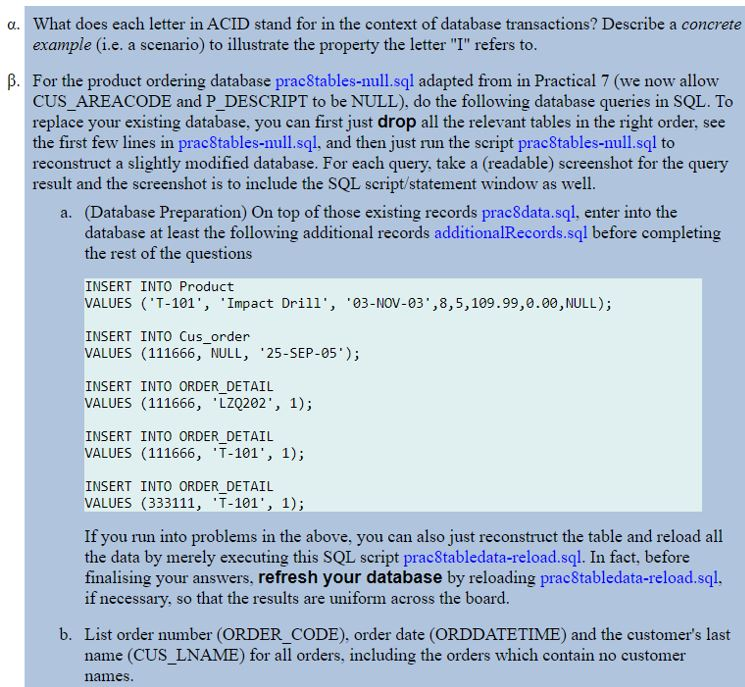(Solved) : Letter Acid Stand Context Database Transactions Describe Concrete Example E Scenario Illu Q43997099 . . .

a. What does each letter in ACID stand for in the context of database transactions? Describe a concrete example (i.e. a scenario) to illustrate the property the letter “I” refers to. B. For the product ordering database practables-null.sql adapted from in Practical 7 (we now allow CUS AREACODE and P DESCRIPT to be NULL), do the following database queries in SQL. To replace your existing database, you can first just drop all the relevant tables in the right order, see the first few lines in prac Stables-null.sql, and then just run the script practables-null.sql to reconstruct a slightly modified database. For each query, take a (readable) screenshot for the query result and the screenshot is to include the SQL script/statement window as well. a. (Database Preparation) On top of those existing records prac8data.sql, enter into the database at least the following additional records additionalRecords.sql before completing the rest of the questions INSERT INTO Product VALUES (‘T-101’, ‘Impact Drill’, ’03-NOV-03′,8,5,109.99,0.00,NULL); INSERT INTO Cus_order VALUES (111666, NULL, ’25-SEP-95′); INSERT INTO ORDER_DETAIL VALUES (111666, ‘LZQ202’, 1); INSERT INTO ORDER_DETAIL VALUES (111666, ‘T-101’, 1); INSERT INTO ORDER DETAIL VALUES (333111, ‘T-101’, 1); If you run into problems in the above, you can also just reconstruct the table and reload all the data by merely executing this SQL script practabledata-reload.sql. In fact, before finalising your answers, refresh your database by reloading practabledata-reload.sql. if necessary, so that the results are uniform across the board. b. List order number (ORDER CODE). order date (ORDDATETIME) and the customer’s last name (CUS_LNAME) for all orders, including the orders which contain no customer names. Show transcribed image text a. What does each letter in ACID stand for in the context of database transactions? Describe a concrete example (i.e. a scenario) to illustrate the property the letter “I” refers to. B. For the product ordering database practables-null.sql adapted from in Practical 7 (we now allow CUS AREACODE and P DESCRIPT to be NULL), do the following database queries in SQL. To replace your existing database, you can first just drop all the relevant tables in the right order, see the first few lines in prac Stables-null.sql, and then just run the script practables-null.sql to reconstruct a slightly modified database. For each query, take a (readable) screenshot for the query result and the screenshot is to include the SQL script/statement window as well. a. (Database Preparation) On top of those existing records prac8data.sql, enter into the database at least the following additional records additionalRecords.sql before completing the rest of the questions INSERT INTO Product VALUES (‘T-101’, ‘Impact Drill’, ’03-NOV-03′,8,5,109.99,0.00,NULL); INSERT INTO Cus_order VALUES (111666, NULL, ’25-SEP-95′); INSERT INTO ORDER_DETAIL VALUES (111666, ‘LZQ202’, 1); INSERT INTO ORDER_DETAIL VALUES (111666, ‘T-101’, 1); INSERT INTO ORDER DETAIL VALUES (333111, ‘T-101’, 1); If you run into problems in the above, you can also just reconstruct the table and reload all the data by merely executing this SQL script practabledata-reload.sql. In fact, before finalising your answers, refresh your database by reloading practabledata-reload.sql. if necessary, so that the results are uniform across the board. b. List order number (ORDER CODE). order date (ORDDATETIME) and the customer’s last name (CUS_LNAME) for all orders, including the orders which contain no customer names.
Expert Answer
Answer to a. What does each letter in ACID stand for in the context of database transactions? Describe a concrete example (i.e. a …
OR